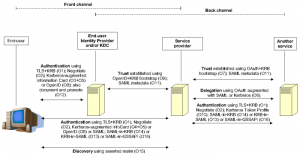[ Update (23-Apr-2011): This spec was published as RFC6125 on 30-Mar-2011. See also this more recent post. ]
Aside from HSTS, which I’ve written about here earlier, I’ve also been working on a specification for “TLS/SSL Server Identity Checking” along with Peter Saint-Andre.
The basic summary is: you have a DNS domain name identifying some application service (aka “a server”) you wish to connect to over TLS/SSL, e.g. “www.example.org”, and once you do so, how do you really know (and check) that the returned PKIX Certificate contains an identifier(s) that maps to the name of the application service you intended to interact with?
This turns out to be a fairly complex endeavor, and up to the present here, various protocol specs have either specified it on their own, or have referenced another spec that has addressed the problem. One such referenced spec is RFC2830, “Lightweight Directory Access Protocol (v3): Extension for Transport Layer Security“, which I co-authored. So anyway, I got involved a few years back in trying to concoct a dedicated specification for how to do TLS/SSL server identity checking in an application protocol neutral fashion. Eventually, Peter Saint-Andre and I signed up to buckle down and make the spec a reality. Much of this work occurred during 2010.
The resulting internet-draft, draft-saintandre-tls-server-id-check, was approved on 20-Jan-2011 as a Proposed Standard RFC, and will be published as such in the next couple of months. It has this fairly precise but unwieldy title:
In the spec (which has been referred to as “-tls-server-id-check” in various email discussion threads (e.g. see the certid@ietf.org list), we provide an appendix of extracts from various current RFCs that specify performing such a check. The hope is that, going forward, emerging specifications can simply reference (i.e. “re-use”), and profile if necessary, the -tls-server-id-check spec. In fact, there’s presently four Internet-Drafts in the RFC-Editor’s work queue that do just that.
=JeffH sez check it out 🙂
